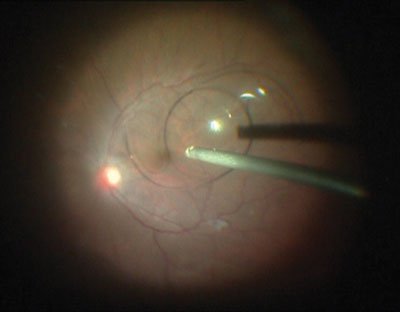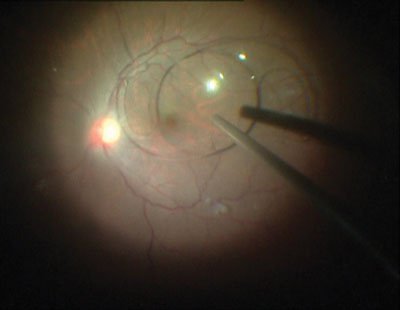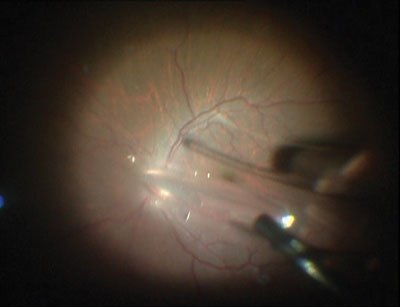Extrusion cannula used for levitation of dropped IOL
Surgeons explain a technique that allows safe, easy access to a dropped IOL with minimal surgical interventions.
Dislocated IOLs in the posterior chamber have always been a cause of concern and a known complication after a posterior capsule rupture. Improper sulcus fixation, dislocation/subluxation of the IOL bag complex or improper judgment about the integrity of the posterior capsule intraoperatively often leads to this complicated scenario. The dislocation of an IOL not only makes the patient aphakic but can also cause complications related to the dropped IOL. Therefore, it is mandatory to explant or reposition the IOL, which in itself has its own complications and requires a major vitreoretinal intervention.
Dropped IOLs
Various methods and techniques have been described to lift dropped IOLs. Grasping instruments such as retinal forceps have been used in the past, but they run the risk of damaging the retina during the process of lifting the IOL. Perfluorocarbons have been used to facilitate the lifting and help in floating the IOL, so that it can be easily picked up. Santos et al proposed the use of a silicone tip aspiration cannula connected to the vitreotome. Olson et al devised a special suction-based grasping cup that could lift the IOL. The fragmatome tip has also been described to levitate posteriorly dislocated IOLs by applying suction.
Extrusion cannula
An extrusion cannula has been used extensively for drainage of subretinal fluid by posterior segment surgeons. The flexible sleeve of the extrusion cannula helps to reach the subretinal space effectively. In our practice, we use extrusion cannulas without sleeves for levitating dropped IOLs. Removal of the sleeve gives a wider area for adherence and subsequent creation of effective suction to the IOL.
Surgical technique
After a standard three-port pars plana vitrectomy procedure (Figure 1) and clearance of all the vitreolenticular adhesions, the sleeveless extrusion cannula is attached to the tubings, which are connected to the vitrectomy machine. Desired vacuum can thus be generated. The extrusion cannula is introduced and brought close to the anterior surface of the optic of the IOL (Figure 2). An effective suction is generated by pressing the foot pedal with a setting at around 300 mm Hg. The IOL is levitated (Figure 3) and brought into the mid-pupillary plane, where it is grasped by end-opening forceps introduced through the side-port incision (Figure 4). The IOL is then explanted or repositioned, depending on the integrity of the sulcus support and the type of IOL that is levitated. Glued intrascleral haptic fixation is our method of choice in patients requiring explantation and a subsequent IOL implantation.

Figure 1. Vitrectomy for dropped IOL.

Figure 2. Sleeveless extrusion cannula placed over the optic of the IOL to lift the IOL by suction.

Figure 3. IOL lifted by suction.

Figure 4. IOL brought anteriorly and haptic held with end-opening forceps.
Source: Agarwal A
The advantage with this procedure is that no special instrument is required for the surgery. Care should be taken to initiate vacuum when the cannula is close to the IOL. This helps prevent any accidental trapping of the vitreous strand in the lumen of the extrusion cannula. Another advantage is that the chances of damaging the retina while levitating the IOL are almost nullified, unlike the grasping instruments used in the vitreous cavity. In our experience, it allows safe and easy access to the dropped IOL with minimal surgical interventions.
